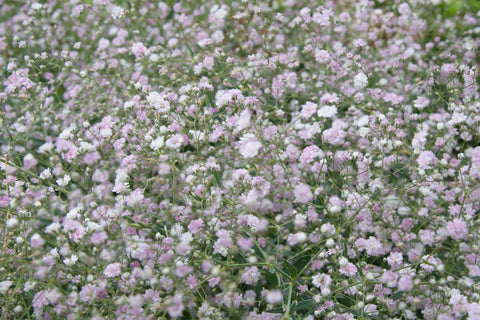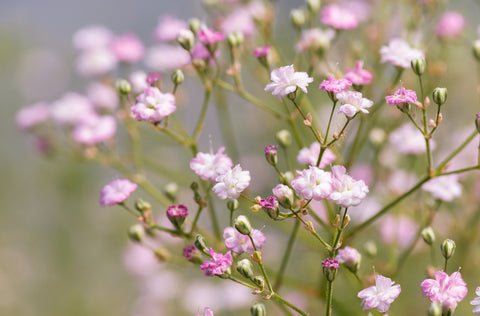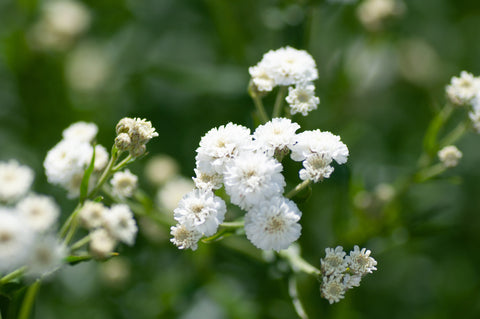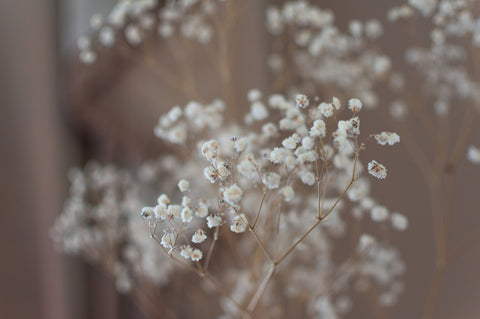The Baby's Breath plant, called Gypsophila Paniculata scientifically, is a flowering perennial plant species. It is a herbaceous perennial, growing up to 1.2 m tall and wide. When you look at the Gypsophila plant initially, your first thought might as well be about how the flowers that adorn this plant look like fluffy little clouds.
• Wondering How The Gypsophila Plants Got Their Name?

The name "Baby's Breath" may sound very peculiar but when you look into why it was named this, you might just agree right away!
The Gypsophila flowers have a very distinct scent to them. They somehow tend to smell like a mixture of a baby's spit-up and milk, but in a not-so-bad way. That's what earns them their name - Baby's Breath!
As if this scent wasn't enough, the flowers that grow look just like fluffy little clouds, thus adding to the allure of the plant.
• Interesting Facts About the Gypsophila Plant

1. Naming
The Gypsophila plant is commonly known as "Baby's Breath" because of its distinct smell that closely resembles a baby's spit up.
2. Symbolism
The flowers of this plant symbolize purity and innocence. The delicate petals add to this symbolism; thus these flowers are often used in wedding floral arrangements to symbolize the pure love of the couple to be wed.
3. Medicinal Uses
Despite being an absolute delight to look at, Gypsophila Paniculata is more than just a pretty face. It has uses in medicinal fields. In herbal medicine, it has been used to treat respiratory issues and certain parts of the plant are also known for their therapeutic properties.
4. Dried Flowers
Gypsophila flowers have great potential to be dried and preserved. If you're fond of preserving flowers, this is one of the easier ones to dry and keep safe. So, you can use these small stunners in floral wreaths, arrangements of dried flowers, and even in potpourri.
5. Pollinator-Friendly
Pollinators adore Baby's Breath flowers. So, if you're trying to create a pollinator garden, the Gypsophila flower plant is a perfect addition!
6. Growing Gypsophila is Super Easy!
Flowering plants can make for tricky additions to gardens . But the Gypsophila plant is easy to grow and becomes a great addition to ornamental or pollinator gardens.
• Growing Gypsophila: Seeds or Stem Cuttings?
It doesn't matter if you're more comfortable growing plants from seeds or stem cuttings because the Gypsophila plant gives you both options!
a. Planting Gypsophila Seeds

1. Prepare the soil by loosening it to a depth of 6-8 inches and incorporating organic matter for improved drainage and fertility.
2. Sow Gypsophila seeds directly into the soil after the last frost date in your area, typically in spring.
3. Scatter the seeds evenly and lightly cover them with a thin layer of soil, as Gypsophila seeds require light for germination.
4. Maintain adequate spacing between seeds to prevent overcrowding once they germinate.
Buy Gypsophila seeds
b. Planting Stem Cuttings

• Selecting Stem Cuttings
1. Choose healthy, non-flowering stems from an established Gypsophila plant for propagation. Opt for stems that are vigorous and free from signs of disease or damage.
2. Select stems that are 4-6 inches long, with several nodes present along the length of the stem. Nodes are points where leaves emerge and where roots will develop.
• Preparing Cuttings
1. Using clean, sharp scissors or pruning shears, make a clean cut just below a node to ensure the stem has the best chance of rooting.
Buy Garden Tools
2. Remove any lower leaves along the stem to expose the nodes where roots will form. Leave a few leaves at the top of the cutting to support photosynthesis.
• Rooting Hormone (Optional)
1. While not essential, applying a rooting hormone can promote faster root development and increase the success rate of propagation.
2. Dip the cut end of each stem cutting into rooting hormone powder, ensuring the powder coats the cut surface evenly.
Buy the Root Shoot Rooting Hormone
• Planting Cuttings
1. Fill small pots or seedling trays with a well-draining potting mix. You can use a mix of perlite, vermiculite, and peat moss for optimal drainage.
2. Insert the prepared stem cuttings into the potting mix, ensuring at least one node is buried beneath the surface. Space the cuttings evenly to prevent crowding.
• Gypsophila Growing Conditions: Basic Baby's Breath Care
Here are a few basic care tips that you must remember so that your Gypsophila plant can thrive in the conditions it requires.

1. Sunlight
The Gypsophila plant thrives in full sun to partial shade. Ensure that it receive at least 6 hours of sunlight daily for optimal growth and flowering. Indoors, you can place your potted Baby’s Breath near south-facing windows to maximize sunlight exposure.
2. Soil
Plant Gypsophila in well-draining soil with a neutral to slightly alkaline pH.; incorporating organic matter such as compost or peat moss into the soil to improve fertility and drainage. Remember to avoid waterlogged soil at all costs as it can lead to root rot.
3. Watering
Maintain consistent moisture levels in the soil, especially during the plant's active growth periods. Water your Gypsophila plant deeply but infrequently, allowing the soil to dry slightly between waterings. Avoid overhead watering to prevent fungal diseases and aim to water at the base of the plant to minimize moisture on the foliage.
4. Fertilization
Feed Gypsophila plants with a balanced fertilizer during the growing season to promote healthy foliage and abundant blooms. Apply fertilizer according to the manufacturer's instructions, usually every 4-6 weeks. Avoid excessive nitrogen fertilizers, as they can stimulate excessive leaf growth at the expense of flowers.

5. Pruning
Regular pruning your Baby’s Breath leaves helps maintain the shape of the plant and encourages continuous blooming. Remove spent flowers promptly to prevent seed formation and promote additional flowering. Additionally, trim any yellowing or damaged foliage to improve air circulation and overall plant health.
6. Support
Taller varieties of Gypsophila may benefit from support to prevent stems from bending or breaking under the weight of flowers. Use stakes or plant supports to prop up stems, especially in windy conditions or when grown in containers.
7. Pest and Disease Management
Monitor Gypsophila plants for common pests such as aphids, spider mites, and powdery mildew. Use natural or organic pest control methods such as insecticidal soap or neem oil to address pest infestations promptly. Ensure good air circulation around plants to reduce the risk of fungal diseases.
8. Overwintering (for Perennial Varieties)
In colder climates, protect perennial Gypsophila plants from frost by applying a layer of mulch around the base of the plant in late fall. This helps insulate the roots and prevent frost damage. Prune back any dead or damaged growth in early spring to promote new growth.









